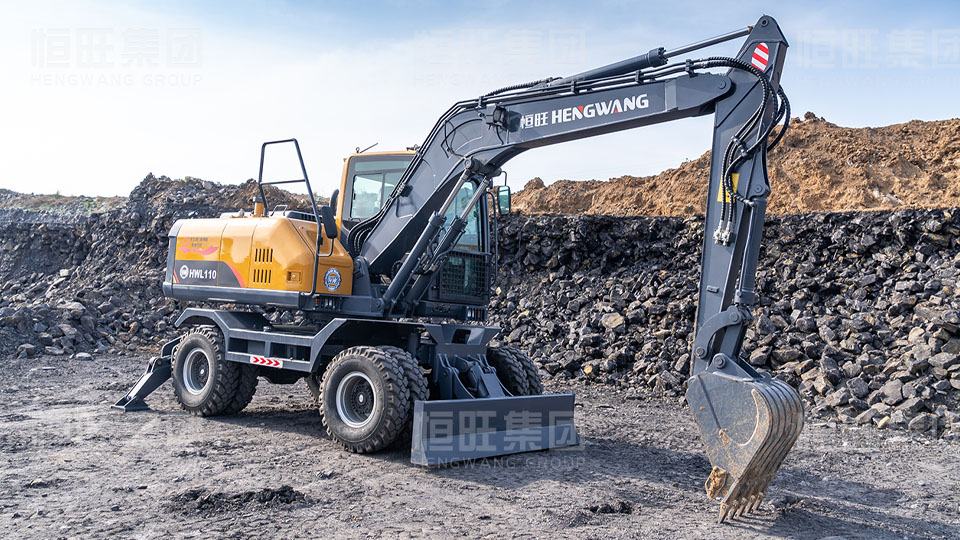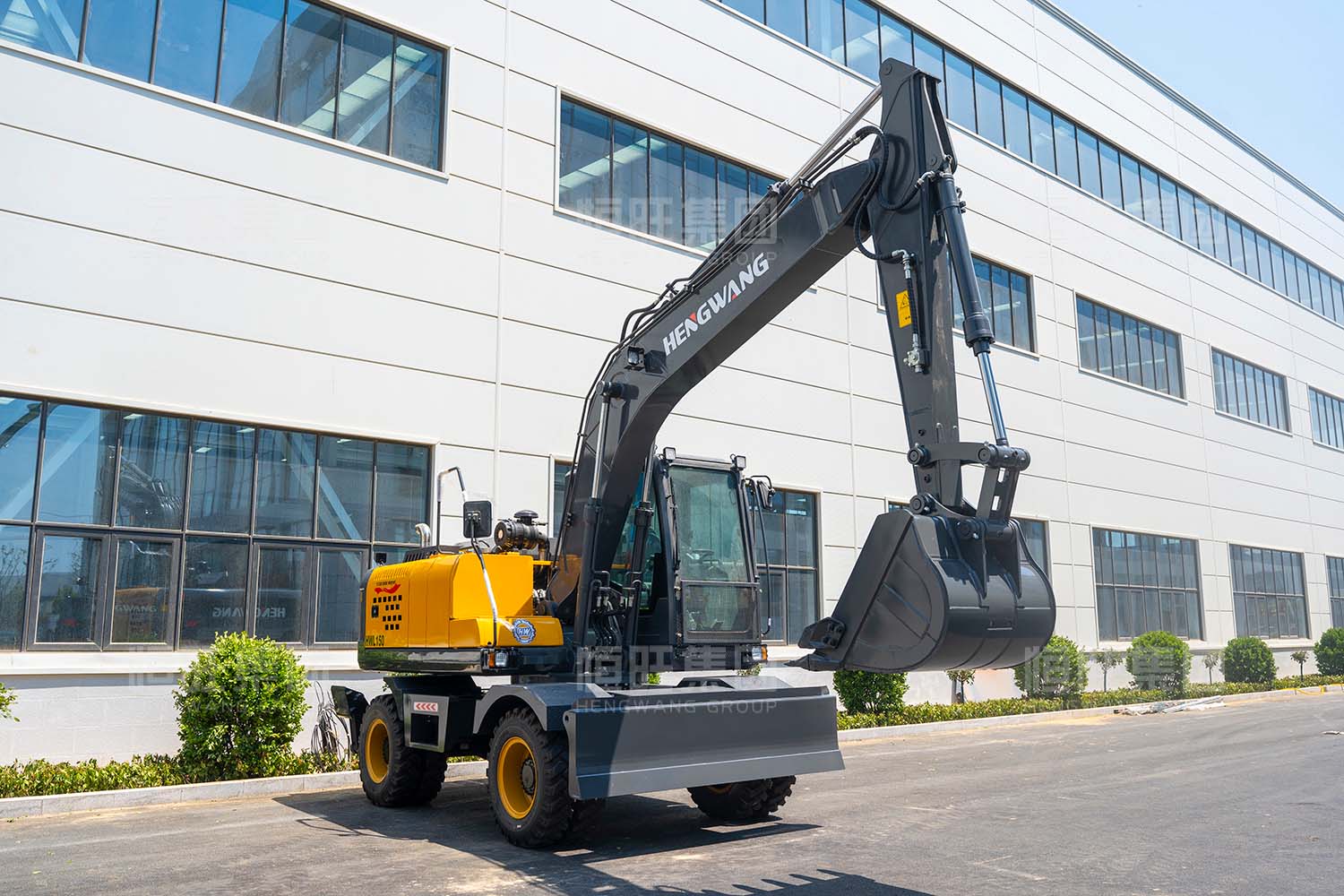I. Application Scenarios and Core Advantages of Wheel Excavators
Wheel excavators have become the mainstay equipment in construction, road engineering, quarrying, and other fields due to their high mobility and multi-functionality. In urban construction, they can directly travel on hardened roads for site transfer without additional transportation equipment, making them particularly suitable for tasks like foundation pit excavation and pipeline laying around buildings. In road construction, they can excavate ditches, load sand and soil onto freight vehicles, and process crushed stone materials through screening buckets. During winter, equipped with hydraulic hammers or grapple attachments, they can quickly clear snow from construction sites. Compared with crawler equipment, their core advantages include:
· Transfer Convenience: Capable of short-distance travel on public roads independently, eliminating the need for special trailers and high transportation costs required by crawler equipment.
· Attachment Adaptability: Reinforced buckets for building demolition, hydraulic hammers for rock breaking, and forks for lifting building materials—truly achieving "one machine, multiple functions."
· Urban Operation Friendliness: Compact body and flexible control ensure safer and more efficient operation in dense urban areas.
II. Key Decision Factors Before Selection: Deriving Equipment Requirements from Working Conditions
(1) Assessment of Working Environment and Task Types
· Terrain Limitations: Wheel excavators are unsuitable for sticky or loose road surfaces. For muddy or soft soil foundations, crawler equipment should be prioritized.
· Task Segmentation: Small municipal projects (e.g., cable laying, community greening): Choose small to medium-sized models for flexibility.
Large quarries or mining operations: Focus on engine power and bucket capacity to ensure continuous operational efficiency.
Multi-scenario switching needs (e.g., earthwork excavation + material loading + site leveling): Confirm the equipment’s ability to quickly replace attachments for different conditions.
(2) Comparison and Trade-offs with Crawler Equipment
Crawler equipment offers stronger stability on rough terrain, suitable for large suburban construction sites or mining scenarios. Wheel excavators, however, excel in transfer efficiency on urban roads and hardened surfaces, with no extra transportation costs for short distances—for example, transporting a heavy crawler excavator and its attachments requires a special trailer, incurring several times the transportation costs of wheeled equipment.

III. Detailed Explanation of Technical Parameters: How to Precisely Match Equipment Performance
The key to selecting a wheel excavator lies in balancing the following core parameters with actual needs:
Engine Power
Determines operational efficiency and load capacity: For large projects (e.g., mining), choose models with over 200 HP; for small municipal projects, 100–150 HP suffices to avoid energy waste from "overpowered equipment for light tasks."
Bucket Capacity
Must match transportation vehicles: For example, a bucket should fill a dump truck in 4–6 cycles. Excessive capacity may overload the hydraulic system, while insufficient capacity reduces efficiency—calculate the optimal value based on specific working conditions.
Driving Speed
For strong urban transfer needs, prioritize models with speeds over 40 km/h to shorten scheduling time between sites and enhance overall project efficiency.
Working Weight and Stability
When the boom is fully extended with a loaded bucket, the equipment’s center of gravity must remain balanced. Unreasonable weight distribution may cause boom fractures or machine overturning, so strictly follow the manufacturer’s recommended bucket and boom combinations.
Lifting Capacity
For material hoisting, clarify the maximum lifting weight and working radius—e.g., when hoisting precast components, ensure the equipment meets load-bearing requirements at the specified distance.
Take the Hengwang HWL-150 new-generation wheel excavator as an example: Its balanced power and weight design suits medium-intensity projects, meeting continuous excavation needs while avoiding overload risks through structural optimization—ideal for projects prioritizing both efficiency and cost control.

IV. Brand and Service System: Invisible Guarantees for Long-term Operation
Post-purchase maintenance costs of construction machinery often account for over 30% of total investment. The core value of choosing an excellent brand includes:
· Spare Parts Supply Efficiency: Niche brands may cause equipment downtime for weeks due to spare parts shortages, while Hengwang, relying on a global service network, enables rapid spare parts allocation.
· Professional Technical Consultation: Brand service providers offer customized selection advice based on specific working conditions (e.g., soil hardness, operation duration), preventing equipment idling or damage from parameter mismatches.
V. Closed-loop Purchase Process: From Requirement Sorting to Implementation
Advance the selection decision in the following steps:
1. Requirement List Making: Clarify the operation scenario (urban/suburban), terrain conditions (hardened/soft), and task types (proportion of excavation/loading/crushing).
2. Parameter Priority Ranking: Initially filter models by the logic of "power ≥ bucket capacity ≥ stability ≥ speed," using text-based comparisons if tables are unnecessary.
3. Field Testing Verification: Focus on the hydraulic system response under full load, boom lifting stability, and cab comfort.
4. Service Clause Refinement: Confirm key terms with the supplier, including warranty period, spare parts supply cycle, and emergency repair response time (e.g., on-site within 24 hours).
Ultimately, selecting a wheel excavator is essentially about "precisely matching working condition requirements with equipment performance." Only by comprehensively evaluating technical parameters, brand services, and actual operation scenarios can you achieve maximum cost-effectiveness of "one machine covering multiple tasks," laying the foundation for engineering efficiency and cost control.
